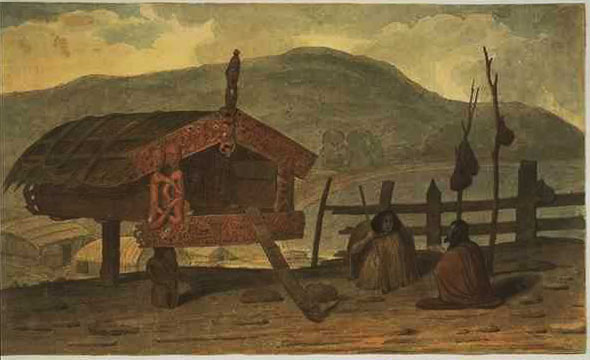
The Wandering Artist
| Augustus Earle's travels round the world 1820-29 |
|
| A tabood store house, Bay of Islands (1827) 20.3 x 34.3 NK12/69 T107 |
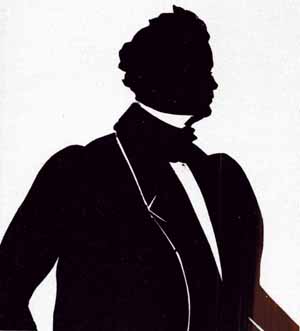 | See Index of WDB pages |
Brief chronology
| 1793 | Born in London, the son of James Earl, an American portrait painter, and Caroline Smyth |
| 1806 | Began to exhibit regularly at the Royal Academy, London |
| 1815-16 | Obtained a passage on a storeship bound for Sicily and Malta; also visited Gibraltar and North Africa en route |
| 1817 | Returned to England |
| 1818 | Left for New York in March and then moved to Philadelphia; exhibited two paintings at the Pennsylvania Academy of Fine Arts |
| 1820 | In February, sailed for Rio de Janeiro, Brazil. Visited Chile in June and was resident in Lima, Peru from July to December. Left for Rio de Janeiro aboard the HMS Hyperion on 10 December |
| 1824 | Joined the Duke of Gloucester in February bound for the Cape of Good Hope and thence to Calcutta (with offers of introduction to Lord Amherst, who had just been appointed Governor of India); on 26 March went ashore at Tristan da Cunha and was stranded there until his rescue by the Admiral Cockburn on 29 November |
| 1825 | Reached Hobart on 18 January; then left for Sydney aboard the brig Cyprus and arrived there on 14 May |
| 1826 | Journeyed inland to the Blue Mountains, Bathurst and the Wellington Valley, and the Hunter River. Then travelled north of Sydney as far as Port Stephens and Port Macquarie |
| 1827 | In April and May, went south to the Illawarra district; left Sydney for New Zealand aboard the Governor Macquarie on 20 October. Only visited that part of the North Island between the Hokianga and the Bay of Islands area during his six-month sojourn |
| 1828 | Returned to Sydney on the Governor Macquarie on 5 May 1828. Finally left Sydney on 12 October on the Rainbow bound for India via the Caroline Islands, Guam, Manila and Singapore. After establishing a reputation in Madras, was forced to leave for health reasons and travelled back to England on two different ships via Mauritius and St Helena. Arrived home in late 1829 |
| 1831 | Joined HMS Beagle, a survey ship, in Plymouth as `Artist Supernumerary with victuals' |
| 1832 | Reached Rio de Janeiro on 4 April but continued ill health again forced his return to England |
| 1838 | Died in London on 10 December of `asthma and debility' |
|
New Zealand The works included here are important as a record of traditional Maori art and culture, long since lost, and also provide information about the early European settlements in the Hokianga and the Bay of Islands area. Earle left Sydney on 20 October 1827 en route to New Zealand where he had `hopes of finding something new for my pencil in their peculiar and picturesque style of life'. Although not the first artist to visit there, he was certainly the first to take up residence. He travelled overland from Hokianga Harbour to the Bay of Islands and back again during the next six months and developed a great respect for the Maoris with whom he came in contact. He was also well placed to observe the impact made on their culture by European whalers, traders and missionaries. After many adventures, he reluctantly boarded the Governor Macquarie on 14 April 1828 when she was ready to sail with `her cargo of kauri planks, flax and potatoes' and returned to Sydney. |

A fortified island in the E.O. Ke Angha [sic] River (1827) 18.7 x 33.7 NK12/68 T106
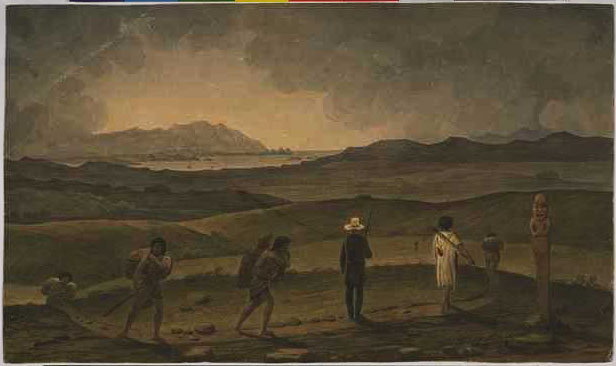
Distant view of the Bay of Islands (1827) 26 x 44.1 NK12/70 T108

A New Zealand family (1827) 8.9 x 11.1 NK12/85 T123
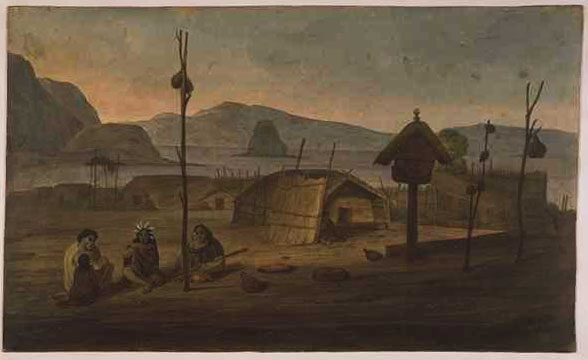
Residence of Shulitea, Chief of Korroradika [Kororareka] (1827-28) 21.9 x 36.2 NK12/71 T109

Scene in Paroa Bay, Bay of Islands (1827-28) 21 x 32.7 NK12/72 T110
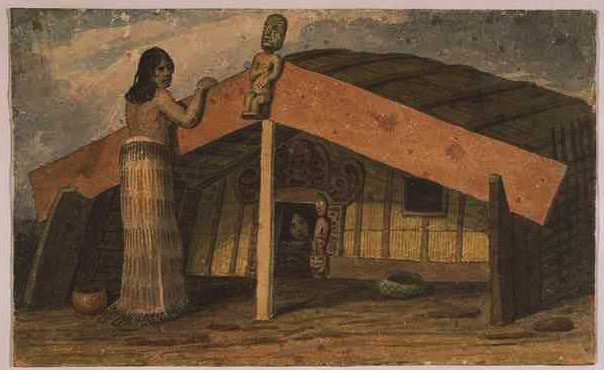
The residence of a New Zealand chief (1827-28)
11.4x18.4 NK12/78 T116

New Zealand warriors and their Queen Trurero (1827-28) 11.1 x 18.4 NK12/79 T117

Amoko, a New Zealand girl (1827-28) 19 x 18.1 NK12/88 T126

A New Zealander (1827-28) 21 x 18.5 NK12/89 T127
| Shipboard life
He also produced at least six watercolours depicting aspects of shipboard life, several of which were later worked up into oil paintings and exhibited at the Royal Academy in London. They include Divine service on board a British frigate (cat. 1), Midshipmens quarters on board a ship of war (cat. 2) and Scudding before a heavy gale off the Cape, lat. 44° (cat. 4). Prior to this time, few artists considered such routine occurrences were worthy of their attention and it was not until the second half of the nineteenth century that genre-type scenes on board ships--particularly prints--gained popularity. |

Divine service on board a British frigate (1820) 17. I x 30.5 NK12/130 T167
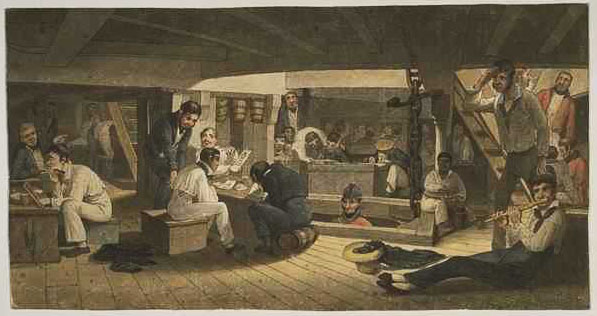
Midshipmens quarters on board a ship of war (1820-21) 17.5 x 33.3 NK12/132 T169
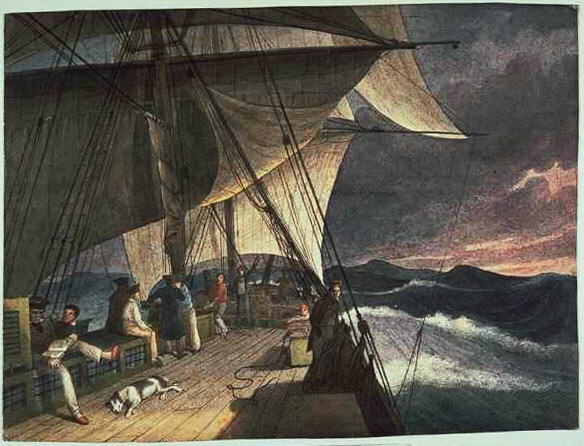
Scudding before a heavy gale off the Cape, lat. 44° (1824) 20.6 x 27.3 NK12/128 T165

Speaking a vessel off the Cape of Good Hope (1824) 21 x 27.3 NK12/129 T166
| Homeward bound
Clearly bored with Sydney society, and frustrated in his attempts to obtain a land grant, Earle departed finally on 12 October 1828 bound for India. He travelled to the Pacific and Asia before disembarking at Madras where he reputedly `acquired both fame and money; and during his short stay there executed the original drawings of that Presidency, which have been since copied and exhibited as a Panorama, by Messrs. Daniell and Parris'. Earle's health soon declined, however, and he was forced to take another two ships back to England. Upon arrival, he wasted no time in capitalising on his experiences abroad and published an eight-part series of Sydney views (1830) as well as an illustrated account of New Zealand and Tristan da Cunha (1832) and a set of New Zealand views (1838). Source: National Library of Australia http://www.nla.gov.au/exhibitions/earle/chrono.html The London-born travel artist, Augustus Earle (1793-1838), left England in 1818 bound for the USA. This was the first stage of a remarkable, round-the-world journey that took him to South America, Tristan da Cunha, New South Wales, New Zealand, the Pacific, Asia, India, Mauritius and St Helena before returning home in late 1829. Most of his predecessors who worked outside Europe had been employed on voyages of exploration or worked abroad for wealthy, often aristocratic patrons. Earle, however, operated quite independently and was fortunate to be able to combine his wanderlust with an ability to earn a living through art. The body of work he produced now comprises what is arguably a unique record documenting the effects of European contact and colonisation during the early nineteenth century. The fifty watercolours selected for this exhibition have been drawn from a group of 161 works that was offered for sale at Sotheby & Co., London in May 1926 by the grandson of Earle's half-brother. Some years later, the works came into the possession of the New Zealand-born art dealer and collection, Sir Rex Nan Kivell (1898-1977), and together with the rest of his collection, were acquired for the National Library of Australia in several stages between the 1940s and 1970s, initially by purchase and later by gift. A major oil painting by Earle, as well as a group of prints, publications and other related material, have also been included in the exhibition. |
Exhibition Itinerary:
National Library of New Zealand, Wellington / 2 August - 19 November 1994
Auckland City Gallery, Auckland / 17 December 1994 - 6 February 1995
Museum of Sydney, Sydney / 9 June - 20 August 1995
National Library of Australia, Canberra ACT - 29 February to 14 July 1996
 | See Index of WDB pages |